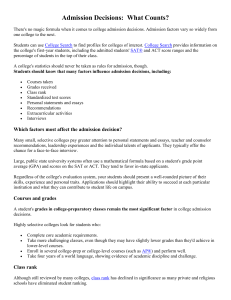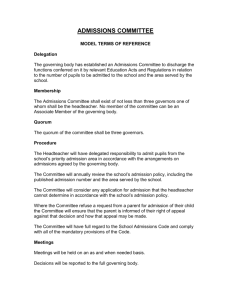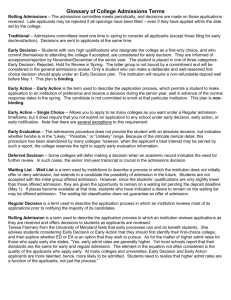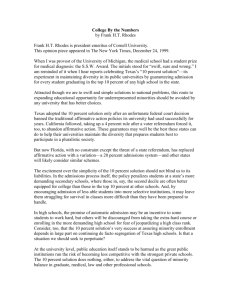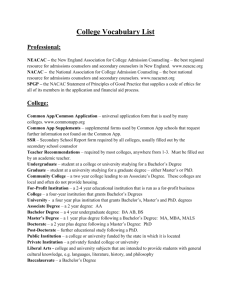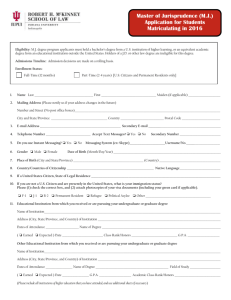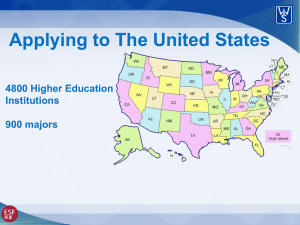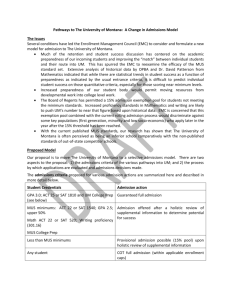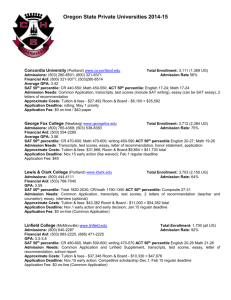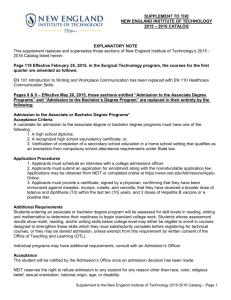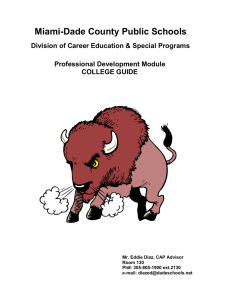College: An institution of higher learning, often referred to as a “four
advertisement
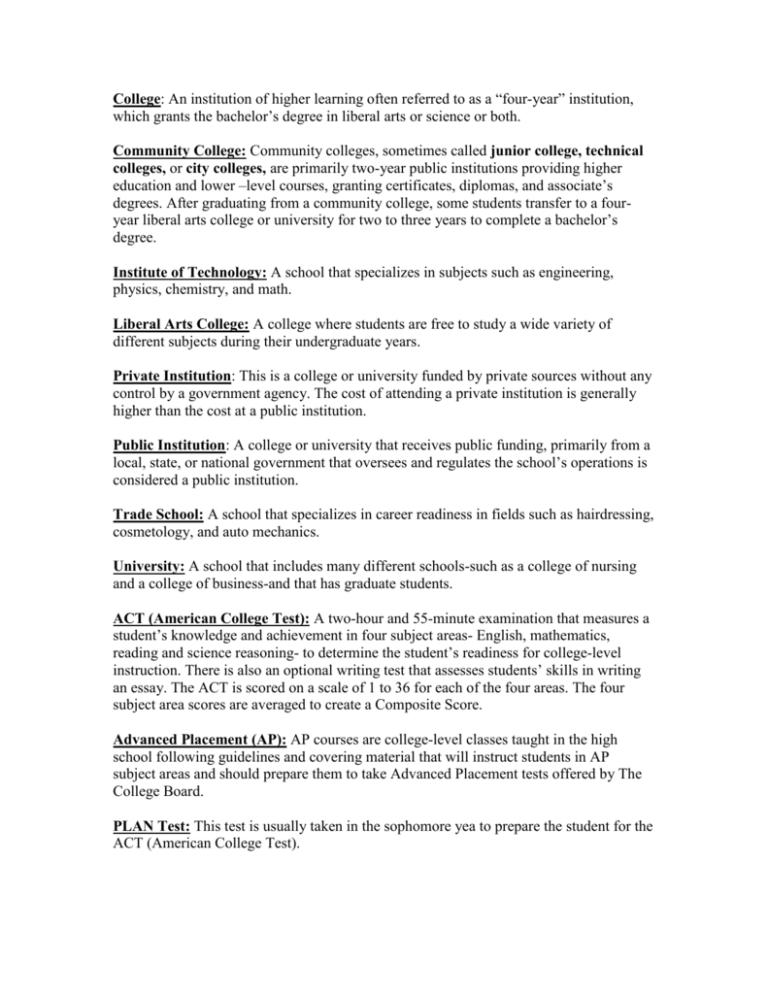
College: An institution of higher learning often referred to as a “four-year” institution, which grants the bachelor’s degree in liberal arts or science or both. Community College: Community colleges, sometimes called junior college, technical colleges, or city colleges, are primarily two-year public institutions providing higher education and lower –level courses, granting certificates, diplomas, and associate’s degrees. After graduating from a community college, some students transfer to a fouryear liberal arts college or university for two to three years to complete a bachelor’s degree. Institute of Technology: A school that specializes in subjects such as engineering, physics, chemistry, and math. Liberal Arts College: A college where students are free to study a wide variety of different subjects during their undergraduate years. Private Institution: This is a college or university funded by private sources without any control by a government agency. The cost of attending a private institution is generally higher than the cost at a public institution. Public Institution: A college or university that receives public funding, primarily from a local, state, or national government that oversees and regulates the school’s operations is considered a public institution. Trade School: A school that specializes in career readiness in fields such as hairdressing, cosmetology, and auto mechanics. University: A school that includes many different schools-such as a college of nursing and a college of business-and that has graduate students. ACT (American College Test): A two-hour and 55-minute examination that measures a student’s knowledge and achievement in four subject areas- English, mathematics, reading and science reasoning- to determine the student’s readiness for college-level instruction. There is also an optional writing test that assesses students’ skills in writing an essay. The ACT is scored on a scale of 1 to 36 for each of the four areas. The four subject area scores are averaged to create a Composite Score. Advanced Placement (AP): AP courses are college-level classes taught in the high school following guidelines and covering material that will instruct students in AP subject areas and should prepare them to take Advanced Placement tests offered by The College Board. PLAN Test: This test is usually taken in the sophomore yea to prepare the student for the ACT (American College Test). SAT (Scholastic Aptitude Test) Reasoning Test: This is a widely used college entrance examination program. This includes the SAT Reasoning Test, which assesses students’ critical thinking skills as they relate to the ability to manage college-level instruction. It is a three-hour exam measuring verbal and mathematical skills, as well as grammar/conventions and the ability to write a brief essay. Students may earn a total of up to 2400 points on the three-hour exam (up to 800 points in each of the exam’s content areas: verbal, math, and writing). SAT Subject Test: SAT subject tests (also known as SAT II tests) are offered in many areas of study including English, mathematics, many sciences, history, and foreign languages. Some colleges require students to take one or more SAT subject tests when they apply for admission. Application: A college application is part of the competitive college admissions system. Admission departments usually require students to complete an application for admission that generally consists of academic records, personal essays, letters of recommendation, and a list of extracurricular activities. Most schools require the SAT or ACT. Deadlines for admissions applications are established and published by each college or university. College Essay: A brief composition on a single subject, required by many colleges as part of the application process for admission. Common Application: The Common Application makes it possible for students to use one admissions application to apply to any of the 456 member colleges and universities. There is a Common Application for First-Year Admission and a Common Application for Transfer Admission. Both versions allow the application to be filled out once online and submitted to all schools with the same information going to each. Early Action: Early action is when a prospective student applies for admission by an early deadline (before the regular admission deadline) and receives notice of acceptance, denial, or deferment with no obligation to the university to enroll, if accepted for admission. Early Decision: Through this program offered by many post-secondary schools, students willing to commit to a school if accepted submit their application by a date well before the general admission deadline. If accepted, the student must enroll in that school, so students should only apply for early decision to their first choice school. Need-Blind Admission: Full consideration of an applicant and his/her application without regard to the individual’s need for financial aid. Open Admissions: This refers to the policy where a college admits virtually all high school graduates, regardless or academic qualifications such as high school grades and admission for test scores. Recommendations: Statements or letters of endorsement written on a student’s behalf during the college application process. Rolling Admissions: This is a practice used by some institutions to review and complete applications as they arrive, rather than according to a set deadline. Transcript: This is the official document containing the record of a student’s academic performance and testing history. The school at which a student is or has been officially enrolled must issue the transcript, certified by the signature of an authorized school administrator. The school’s official seal or watermarked school stationery may also be used to authenticate the transcript. Wait-list: An applicant is put on the wait-list when an admissions officer or committee decides to offer the applicant the opportunity to enroll in the institution only if there is space available in the incoming class after fully admitted students have responded to their offers to enroll. This category of admissions is reserved for students whose profiles are strong, but who are marginally qualified in comparison to the overall strength of others in the pool of applicants. A.A.: This stands for an “associate of arts” degree, which can be earned at most two-year colleges. B.A. or B.S.: B.A. stands for “bachelor of arts”, and B.S. stands for “bachelor of science”. Both degrees can be earned at four-year colleges or universities. Certificates: In an economy that increasingly rewards specialization, more and more institutions are offering certification programs, typically a package of five or six courses, for credit or not, taken over three to eighteen months. Some cost a few thousand dollars, others much more.



